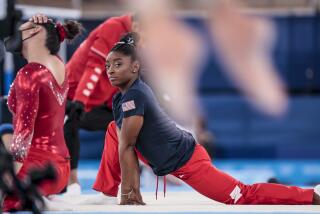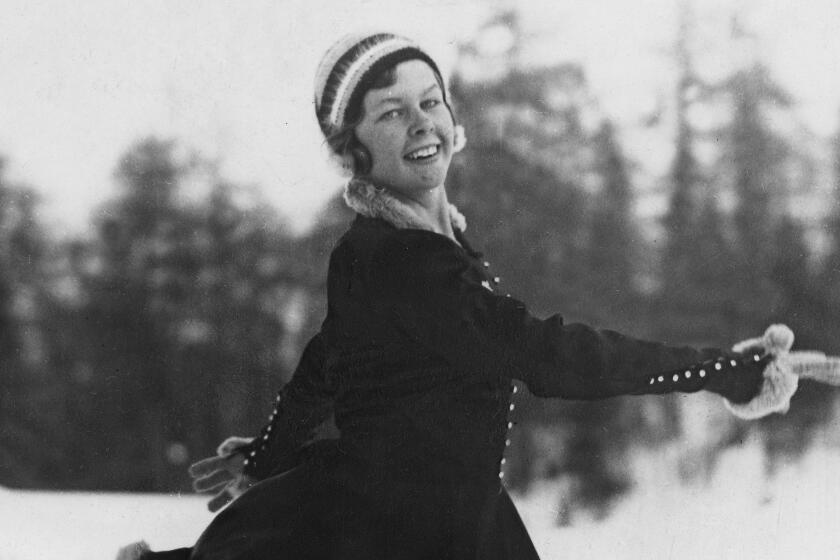Olympic Rule Puts Spotlight on Asthma and Exercise
When the 2002 Winter Olympics begin Friday, we will be hearing about many medical marvels: There’s the snowboarder with a liver transplant, the Alpine racer who shattered his leg in a motorcycle crash and an aerial skier who broke her back during a performance but finished anyway.
Yet doctors say the Games will also put a spotlight on a far more common, and familiar, health condition--asthma. “Asthma could become one of the big stories of these Games,” said Dr. John Weiler, an allergist at the University of Iowa who has studied Olympic athletes.
That’s because, for the first time, Olympic officials will require athletes taking asthma medication to prove their diagnosis with lab results and other documentation--or risk disqualification.
Until now, officials have largely taken athletes at their word if they claimed to be asthmatic. But because of uncertainties about asthma drugs--some believe the inhaled drugs help enhance performance; other experts disagree--only athletes who can prove they suffer from the disease will be cleared to compete while dosing themselves.
The International Olympic Committee’s Medical Commission has good reason to suspect that some athletes falsely claim to be asthmatic: The rate of reported asthma among U.S. Olympians has doubled from 11% in 1980 to 22% in 2000, according to surveys of athletes. Rates among endurance athletes, such as Nordic skiers, range as high as 40% to 50%--six to seven times the rate in the general population.
Following the 2000 Summer Olympics in Sydney, Australia, Prince Alexander de Merode, head of the IOC Medical Commission, described the high incidence of asthma as “very bizarre” and quipped that “it looks like the Games for the Sick.”
Yet most doctors who treat asthmatics say the increase among Olympians is not bizarre: Asthma rates surged in the general population during the 1980s and 1990s. Endurance athletes are at particularly high risk, because the sheer volume of air they move through their lungs during training exposes them to high levels of allergens and pollutants that researchers believe trigger the disease.
“These athletes breathe in anywhere from 30 to 200 times more air than non-athletes do,” said Dr. Christopher Randolph, an allergist and associate clinical professor at Yale University School of Medicine. “With all that hyperventilation, they are also getting a lot more of whatever’s in the air, whether it’s pollen or the sort of pollution you see in the Los Angeles area. So if you’re getting all that air, and if you have an allergy, you’ve got a recipe for a big problem.”
A chronic lung-tightening condition, asthma now afflicts 12 million to 15 million Americans, or about 6% of the population, up from 3% to 4% in the 1980s. Hospitalizations due to asthma have increased significantly in the last two decades; and deaths due to the disease have doubled, to more than 5,000 a year, including high-profile cases such as that of Rashidi Wheeler, the Northwestern University football player who collapsed and died on the field last summer. Doctors later attributed his death to exercise-induced bronchial asthma.
“Asthma has become epidemic, and no one really knows why,” said Dr. Susan Sprau, a pulmonologist and associate clinical professor at UCLA School of Medicine.
Many doctors think the Olympic committee’s crackdown on asthmatics is heavy-handed, because it casts suspicion on hundreds of athletes with a very real medical condition, who rely on asthma inhalers to catch their breath. On the other hand, researchers say the IOC’s requirement for disclosure of medical records may help doctors gain a better understanding of how to manage one of the most common triggers of asthma--exercise--which could help improve treatment for millions worldwide.
The new rules, said Weiler, should yield “much more solid numbers on these athletes,” and how they’ve handled the disease.
That asthmatics can master grueling competitive sports is beyond doubt. Jackie Joyner-Kersee, who won gold medals in the 1988 and 1992 Summer Olympics, suffers from chronic asthma; so does Amy Van Dyken, the U.S. swimmer who won four gold medals in 1996.
Yet heavy training regimens may exacerbate the condition, doctors suspect. In sensitive individuals, for example, dry air may dehydrate lung membranes, causing inflammation; and cool dry air in particular could cause further strain on the air passageways. That helps explain why asthma rates are so high in Nordic skiers, experts said. All that cold, dry air rushing into skiers’ lungs pushes otherwise healthy people over a threshold.
The result is an exercise-induced attack, which is familiar to any asthma sufferer: chest tightness, wheezing, the feeling of “breathing through a straw,” as some sufferers describe it. If not treated, these spasms may cause permanent damage over time, even in some people whose asthma attacks are brought on only by exercise, some researchers say.
“What we think happens in many asthmatics is lung remodeling,” Sprau said. “Fibers in lungs thicken, muscles get bigger, which narrows the airways, there’s more mucous secretion, all of which causes further blockage.”
While athletes obviously manage asthma differently, there are several rules that most follow: Drink lots of fluids; breathe through the nose as much as possible (it helps filter impurities and warms the air); warm up before exercise; wind down slowly. And use an inhaler when necessary. “A couple of puffs on a bronchodilator 20 minutes before exercise to prevent a problem; and perhaps another few puffs when the competition is over” is typical, Sprau said.
Adhering to this regimen is especially important for those who exercise in an environment with a lot of dirt and smog in the air--such as Southern California. In a study released Friday, USC researchers report that preteen and teenage athletes playing three or more sports tripled their risk of developing asthma if they lived in an area with high ozone concentration. Though researchers had suspected as much, the new study provides some of the best evidence to date that ozone contributes to the development of the disease.
“I truly hope that the Olympic committee position doesn’t put people off taking medication if they need it,” Weiler said. “I see a lot of athletes who think they have to stop taking the drugs because they’ve heard they’re banned. But this is only an Olympic thing. It’s got nothing to do with NCAA or high school athletes.”
More to Read
Go beyond the scoreboard
Get the latest on L.A.'s teams in the daily Sports Report newsletter.
You may occasionally receive promotional content from the Los Angeles Times.







